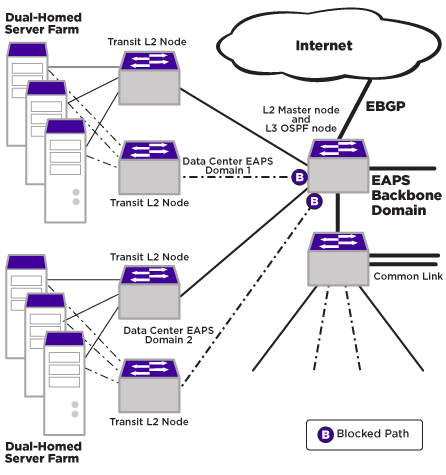Building from the network core, you can expand the network with additional EAPS (Extreme Automatic Protection Switching) rings to provide resiliency to mission-critical server farms.
The core switches provide high performance backbone routing between the data center and the rest of the network, which includes both internal and external (Internet) destinations. The core switch acts as the EAPS master node for each ring, while the data center switches act as EAPS transit nodes to complete the ring. The core switch also acts as the OSPF (Open Shortest Path First) routing node to provide gateway routing functionality to the server-farms. For an additional level of resiliency, each server is dual-homed (dual attached) to both EAPS transit L2 switches. Even if a switch or link fails, the servers are available.
The network design and configuration is similar to the edge and aggregation EAPS and OSPF layers. The modular approach is simple and scalable, and allows additional data center rings to be added to provide room for growth. In our example, server-farms are isolated into separate categories such as external and internal service groups, which yield additional security and resiliency benefits.
To configure the data center switches, you need a new EAPS domain with a single EAPS protected VLAN (Virtual LAN) to form the server-farm network. In this example, two data center switches are configured as EAPS transit nodes (L2 switch only) and attach to the existing core switch acting as the EAPS master. Each server in the server-farm is dual-homed to both EAPS transit switches in the data center for additional physical resiliency. IP routing functionality is performed by the core switch via OSPF, which provides L3 connectivity to the rest of the network.

To configure data center connectivity, complete the tasks described in the following sections:

 Print
this page
Print
this page Email this topic
Email this topic Feedback
Feedback